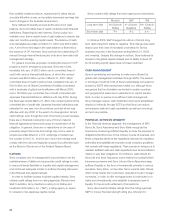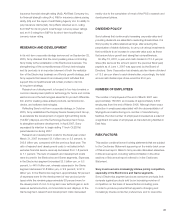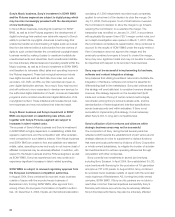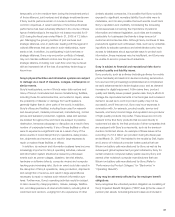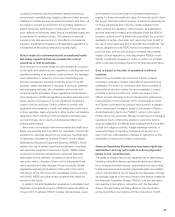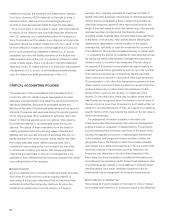Sony 2007 Annual Report Download - page 93
Download and view the complete annual report
Please find page 93 of the 2007 Sony annual report below. You can navigate through the pages in the report by either clicking on the pages listed below, or by using the keyword search tool below to find specific information within the annual report.90
holders and will pay the dividends and distributions collected
from Sony. However, ADS holders will not be able to bring a
derivative action, examine Sony’s accounting books and
records, or exercise appraisal rights through the depositary.
Sony Corporation is incorporated in Japan with limited liability.
A majority of our directors and corporate executive officers are
non-U.S. residents, and a substantial portion of the assets of
Sony Corporation and the assets of our directors and corporate
executive officers are located outside the U.S. As a result, it may
be more difficult for investors to enforce against Sony Corpora-
tion or such persons the judgments obtained in U.S. courts
predicated upon the civil liability provisions of the federal and
state securities laws of the U.S. or judgments obtained in other
courts outside Japan. There is doubt as to the enforceability in
Japanese courts, in original actions or in actions for enforcement
of judgments of U.S. courts, of civil liabilities predicated solely
upon the federal and state securities laws of the U.S.
CRITICAL ACCOUNTING POLICIES
The preparation of the consolidated financial statements in
conformity with U.S. GAAP requires management to make
estimates and assumptions that affect the reported amounts of
assets and liabilities, disclosure of contingent assets and
liabilities at the date of the financial statements and the reported
amounts of revenues and expenses during the reporting period.
On an ongoing basis, Sony evaluates its estimates which are
based on historical experience and on various other assump-
tions that are believed to be reasonable under the circum-
stances. The results of these evaluations form the basis for
making judgments about the carrying values of assets and
liabilities and the reported amounts of expenses that are not
readily apparent from other sources. Actual results may differ
from these estimates under different assumptions. Sony
considers an accounting policy to be critical if it is important
to its financial condition and results, and requires significant
judgments and estimates on the part of management in its
application. Sony believes that the following represent the critical
accounting policies of the company.
■INVESTMENTS
Sony’s investments are comprised of debt and equity securities
accounted for under both the cost and equity method of
accounting. If it has been determined that an investment has
sustained an other-than-temporary decline in its value, the
investment is written down to its fair value by a charge to
earnings. Sony regularly evaluates its investment portfolio to
identify other-than-temporary impairments of individual securities.
Factors that are considered by Sony in determining whether an
other-than-temporary decline in value has occurred include: the
length of time and extent to which the market value of the security
has been less than its original cost, the financial condition,
operating results, business plans and estimated future cash flows
of the issuer of the security, other specific factors affecting the
market value, deterioration of credit condition of the issuers,
sovereign risk, and ability to retain the investment for a period of
time sufficient to allow for the anticipated recovery in market value.
In evaluating the factors for available-for-sale securities whose
fair values are readily determinable, management presumes a
decline in value to be other-than-temporary if the fair value of
the security is 20 percent or more below its original cost for an
extended period of time (generally a period of up to six months).
This criteria is employed as a threshold to identify securities
which may have a decline in value that is other-than-temporary.
The presumption of an other-than-temporary impairment in such
cases may be overcome if there is evidence to support that the
decline is temporary in nature due to the existence of other
factors which overcome the duration or magnitude of the
decline. On the other hand, there may be cases where impair-
ment losses are recognized when the decline in the fair value of
the security is not more than 20 percent or such decline has not
existed for an extended period of time, as a result of considering
specific factors which may indicate the decline in the fair value is
other-than-temporary.
The assessment of whether a decline in the value of an
investment is other-than-temporary often requires management
judgment based on evaluation of relevant factors. Those factors
include business plans and future cash flows of the issuer of the
security, the regulatory, economic or technological environment
of the investee, and the general market condition of either the
geographic area or the industry in which the investee operates.
Accordingly, it is possible that investments in Sony’s portfolio that
have had a decline in value that are currently believed to be
temporary may determine to be other-than-temporary in the
future based on Sony’s evaluation of additional information such
as continued poor operating results, future broad declines in value
of worldwide equity markets or circumstances in market interest
rate fluctuations. As a result, unrealized losses recorded for
investments may be recognized into income in future periods.
■VALUATION OF INVENTORY
Sony values its inventory based on the lower of cost or market.
Sony writes down inventory to an amount equal to the difference


